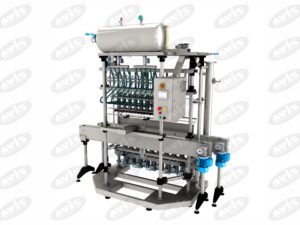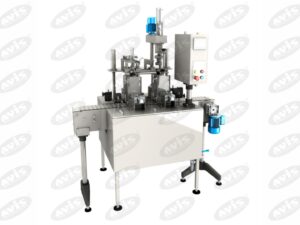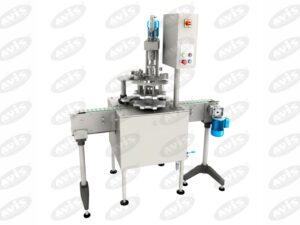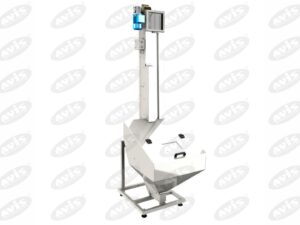The capping machine is designed for automatic capping of plastic or glass bottles with volumes from 0.2 up to 2.0 liters with polyethylene screw caps or rolled aluminum caps. The standard set comprises automatic cap positioner but can be supplied without it. To work with glass bottles it is supplied with the head for rolling in aluminum caps produced by AVIS company.
Filled bottles, moving along the conveyor, reach the automatic capping machine and get onto the rotating table. During its rotation the bottles remove screw caps from the cap remover and after that, at the next stage, they are successively placed under the capper head. The capping head with magnetic clutch that allows mechanically adjusting the tightening force of the caps is applied on the machine. If the cap is missing, the machine automatically stops.
The position accuracy of the rotating table (turnstile) is set by the slot sensor, installed under the machine body, and the plug, driven by the pneumatic cylinder, fixing the bottle under the stopping ring during capping. The table drive – gear motor, which, in contrast to the ratchet gear, allows accelerating the machine up to 3000 bottles/hour.
When changing the bottle format, one turnstile is completely replaced by another one and the correct height of the rotating table is set by the adjusting screw. Additional adjustments of the cap removal are usually not required, therefore, the changeover time from one bottle type to another one takes not more than 10 minutes.
The capping machine of UA-3000-S series is equipped with the convenient controller, in which the precise settings for necessary delays are set. To work with PET bottles the machine also has the magnetic head, which is adjusted by the force of screwing caps onto the bottles.
Distinctive features:
- Capping head with magnetic clutch to adjust the tightening force
- Sensors of bottle availability and blockage
- Electric drive of the rotating table
- Replaceable sets to work with different bottles
- Tight clamping of the bottle by “the body” and under the stopping ring during movement and capping













